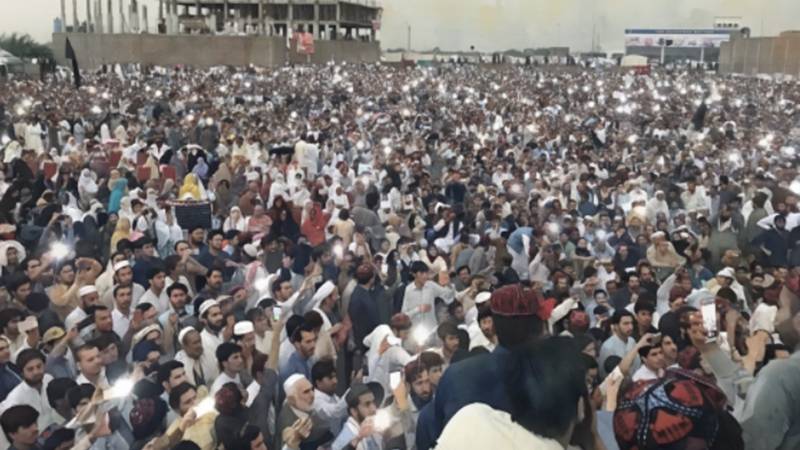
In a historical moment when the very foundations of a social order begin to crumble, Antonio Gramsci foresees an ‘organic crisis’. The crisis consists precisely, he believes, in the fact that the “old is dying and the new cannot be born; in this interregnum a great variety of morbid symptoms appear.”
“Now is the time of monsters” has taken the place of the last phrase in vogue. It is now a widespread contention that the old world is dying everywhere; as a consequence of new possibilities of communication, and means of politics, owing majorly to advancement in digital sphere. The social-media-savvy youth in South Asia and sub-Saharan Africa are the particular points of reference in drawing such a picture of the changing political landscape.
The rise of PTI is regarded as the emergence of new historical bloc in the mainland Pakistan, and the political manifestation of its desire to replace the dying old order is more and more an established argument.
Perpetual war provided space for new enterprises in the sphere of politics and economy. This gave birth to a new elite who owed their newly acquired status to smuggling, scrap, transportation and other such activities, mainly associated with the war economy and the patronage of the perpetrators of war
My effort here is to map the political landscape among the Pashtuns. In Pashtun peripheries, the last few years have been eventful and phenomenal, to say the least. The accumulative resentment against the last two decades of military operations and violence – killing thousands and displacing millions – is resulting in the consolidation of voices of dissent. The emergence of Pashtun Tahaffuz Movement (PTM) is the chief articulation of this new epoch, buttressed by the organic support of young Pashtuns efficiently using social media as a tool for digital resistance. This process is driven by yet another class among Pashtuns – the urban middle class – which believes that it is time to mark their presence in the mainstream, including a large diaspora community which feeds into the same class. These strata of society which have emerged after 9/11 are not uniform in their political ideas and their image for the future.
The War on Terror and the subsequent military operations turned the Pashtun peripheries upside down. They brought mass displacements, bulldozing of villages and bazars, and uprooting of the local economy. More consequential, perhaps, was the frantic and systematic erosion of the socio-political and socio-cultural order (recall the killing of hundreds of ANP cadres and tribal elders). On the flip side, many among the Pashtuns were the agents of that very destructive war machine. Perpetual war provided space for new enterprises in the sphere of politics and economy. This gave birth to a new elite who owed their newly acquired status to smuggling, scrap, transportation and other such activities, mainly associated with the war economy and the patronage of the perpetrators of war. A trasformimo (transformism), that gave Pashtun society a new form.
A large part of this incorporative dynamics of trasformismo, without any question, involved corruption, patronage and clientelism. It is a common sight in Quetta and Peshawar: overnight change in status (and stature) of people linked obscurely with the war economy. It comes with large palatial homes, huge convoys of luxury vehicles and reckless display of arms. Rubbing shoulders with high authorities, these individuals – called Hajis in local parlance – on one hand suggest human agency acting on immediate material interest instead of ethnic solidarity on ideological lines, on the other hand, demonstrate the internal flexibility of the ruling classes to garner the required support by molecularly incorporating social groups and individuals to the established order. The Hajis also signify a ‘fusion between the old and the new.’
My aim here is to bring into question the conflicting changes in the society, and the inherent contradictions of these shifts. That the vying developments may transpire into contestation between the molecularly incorporated groups of the trasformismo, with its antithesis, scission – a situation in which the dominated group consciously embodies a political rupture that goes against the established order. In our case PTM embodies this rupture. These changes in Pashtun society at macro and micro level, mark a departure from the old days, with that, everything that mattered in the old days. Thus giving birth to an organic crisis.
At the root of this organic crisis, beside other factors, is the ‘crisis of authority’, a moment where social classes have ceased to recognise the political parties that previously guarded –and guided – their interests. The popularity of the Pashtun Tahaffuz Movement (PTM) partly lies in the fact that it explicitly denies participation in – and implicitly abhors – the democratic representation through electoral mechanism. Foreseeably then, declining support of political parties is conducive to the rising popularity of PTM. This is especially more so as the nationalist political parties are mocked for ‘floating above’ the society – incognizant of the new social realities.
The old guards of Pashtun nationalism, notwithstanding their past glory, are struggling against today’s populist (and popular) political forces. The landed gentry which constitutes the old parties’ leadership is humiliated by their contestants from very humble backgrounds with a short political history. In desperation, they sometimes seem to toe the line of those very populist forces - and fail badly at it. If anything, it suggests that they are not in sync with present reality.
What, then, is the course of action for a class that begins to separate itself from the bourgeois elite, who, until this point, were able to incorporate and accommodate the people's interests and sentiments in their political programs? Such socio-political disintegration is the terrain where a Caesarist solution is likely to emerge.
Caesarism, a term coined by Gramsci, refers to the rise of ‘a great personality’ who epitomises the saying, “cometh the hour, cometh the man” — a figure poised as a solution to the uncertainties of the political moment, or even as a ‘savior or redeemer of the nation.’ No one fits this description better in the eyes of many than Manzoor Pashteen, especially among the Pashtun population, even across the Durand Line. But does this signal the end of uncertainty? Certainly not.
Manzoor Pashteen undoubtedly resonates with millions of Pashtuns, particularly the young. Paradoxically, many of his supporters are also ardent followers of PTI Chief, Imran Khan. PTI enjoys strong popular support in the very stronghold of PTM, Waziristan. How these political subjectivities—stemming from two fundamentally different political programs—reconcile remains uncertain. Perhaps the more pressing question is how Manzoor Pashteen plans to accommodate these conflicting ideas within his program. Thus far, his strategy seems heavily reliant on mass gatherings. As a charismatic leader, pulling crowds is the easiest part. The real challenge lies in uniting these people under a coherent political worldview with an organisational structure that can endure over time. In this regard, PTM has not made significant progress. How, then, does he intend to translate mass support into practical gains? He must have a plan.
Regarding more recent events, despite their allegiance to different political parties and movements, large numbers of people have united in their rallying for peace. The government's announcement of a fresh military operation (Azm-e-Istehkam) has been met with widespread condemnation across Pashtun society. Last year, the peace marches were concentrated in the Malakand and greater Peshawar valley regions; this time, the southern districts of Khyber Pakhtunkhwa, including Bannu, Lakki Marwat, and Karak, have seen large turnouts. For a moment, it appears that the masses are ahead of the political parties, and these parties will need to step up to keep pace with public sentiment. Initial signs suggest that some, if not all, are attuned to the public pulse. The day after the Bannu peace march, a delegation of ANP leadership arrived to express solidarity with the demands of the marchers.
That said, there is no denying that PTI has a strong support base in Khyber Pakhtunkhwa, particularly in the cultural and economic capital of the Pashtuns, the Peshawar valley. The center-right PTI cannot, beyond a certain limit, go with the flow of the masses and will eventually have to align with the establishment.
Contrary to what some believe, contemporary Pashtun society is neither homogeneous in texture nor uniform in its stance toward the state structure. It is worth noting that the urban and semi-urban centers of Khyber Pakhtunkhwa are well integrated into the system and often view ethnic-nationalist politics as either romanticised or backward-looking. However, it is also fair to assert that a vast majority is weary of the old ways in which they are treated and desires a new arrangement. But is the current leadership capable of guiding this epoch in a political direction that aligns with the long-standing demands of Pashtuns—peace, dignity, and equity among ethnic groups? There is no confident answer to this question.
A look at the past few years paints a grim picture regarding the plausibility of pan-Pashtun solidarity or a political alliance in the near future. Each party, on several occasions, in response to various events and issues, has hosted a jirga or all-parties conference. Yet, each time, the host's efforts are undermined by other parties. Compounding these ego-driven moves against one another is the unfortunate fact that these gatherings have had little to no impact on the ground. Almost all of them concluded with a declaration—and nothing more.
This brings us to the original and troubling situation: what is struggling to surface as the old world dies. It is important to recall that Mussolini was born out of such a juncture of disintegration. This is not, in any way, a comparison between the non-violent, civil rights peace marches or movements and a fascist ideology, but rather a reminder of the significance of the moment. For no matter how organic a crisis may be, it can nonetheless manifest in political conjunctures that are not organically determined as such. In other words, it can lead to uncharted territories and events that do not necessarily reflect ground realities. When masses are fervently involved, the risks can only be roughly estimated. The situation, therefore, demands an honest and rational debate among the Pashtun nationalist cadre—one that can be translated into a grounded political program resonating with the vast majority of the people.

